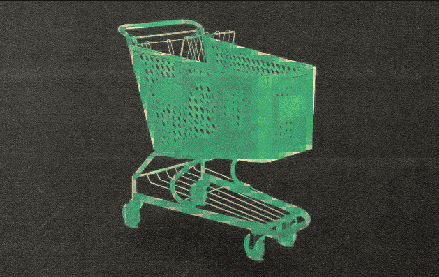Join us Dec. 1-3 in New Orleans for the Digiday Programmatic Marketing Summit

The Trade Desk is at a crossroads. Companies don’t make this many moves unless they see storm clouds on the horizon. Between intensifying competition and a bruised reputation, the pressure is real. Still, the first quarter proved it’s far from faltering. Digiday listened in on the company’s earnings call and spoke with clients, partners and industry insiders to get a read on what’s next — for better or worse.
Getting closer to more advertisers
No surprise here: The Trade Desk is doubling down on direct deals with big advertisers. These joint business plans are essentially structured trading deals and are being struck at an all time high, said CEO Jeff Green. The logic is simple: more deals mean more ad dollars flowing through its pipes — and therefore more opportunities to take a cut. Already, over 40% of the spend on the platform comes from these deals, which are growing 50% faster than overall spend, said Green.
… Just like everyone else in ad tech
Of course, The Trade Desk isn’t the only one chasing closer ties with advertisers. Across the industry, vendors are waking up to the same reality: winning on inventory aggregation or superior data signals is a dead end. The real power lies in controlling ad dollars. That’s why ad tech firms built for publishers are pivoting toward the buy-side, and it’s why agencies that funnel massive budgets into platforms like The Trade Desk are now building their own programmatic marketplaces. Everyone’s scrambling for leverage. The Trade Desk just happens to be a few steps ahead — for now.
“I’ve spoken to a DSP recently and they told me they’re now running into supply-side platforms when they sell to advertisers,” said W Media Research’s principal and chief analyst Karsten Weide. “It’s not like SSPs can’t pull this off even if going direct [to advertisers] is a double-edged sword for those businesses.”
A fairer market
Call it the open web, the premium or the programmatic marketplace — whatever the label it’s about to get fairer for everyone not named Google. Or so says Green. Now that a judge has ruled Google illegally monopolized how digital ads are bought and sold, Green believes the company will be forced to loosen its grip. If that happens, The Trade Desk stands to gain in a big way. Why? Because a more impartial auction could mean better access to inventory and better pricing for the advertisers and publishers in its corner.
Green added: “We were winning in an unfair market, and now that the market is getting fairer we believe that we can compete even better in a fair market.”
Kokai isn’t loved but its working
Not everyone’s thrilled with Kokai, The Trade Desk’s push to automate more of its platform. Some advertisers say it’s made media buying more complicated, especially without full transparency into how impressions are being bought. But even with the gripes, adoption hasn’t slowed. Two thirds of clients are using Kokai — and seeing real gains. On average, those campaigns are delivering a 42% reduction in unique reach, a 24% drop in cost of conversion and a 20% cut in cost per acquisition. They’re also using 30% more data points per impression. In short, it may not be popular but it’s performing.
OpenPath: still controversial, still climbing
When The Trade Desk launched OpenPath three years ago, it was pitched as a cleaner, more direct programmatic pipeline for publishers, But some saw it as a power grab — yet another way for the company to control the flow of ad dollars. Those concerns haven’t disappeared entirely but they’re looking more like paranoia than prophecy. During the earnings call, Green highlighted how OpenPath has delivered real value to publishers. The Arena Group saw fill rates quadruple and programmatic revenue jump 79%. The New York Post more than octupled its fill rate and nearly doubled its programmatic revenue. In CTV, VIZIO saw programmatic revenue rise 39%, and another unnamed major network reported a sevenfold increase in fill rate, leading to a 25% revenue boost. Results like these speak louder than fear.
“We don’t expect OpenPath to be the only supply chain for us. We don’t expect it to even be the primary one, especially given the Google verdict,” said Green on the call. “However, OpenPath is a canary in the coal mine that helps us better understand the supply chain, and often, the games and tactics of obfuscation are best discovered through some form of A/B testing.”
Don’t sleep on Amazon
Green was quick to dismiss Amazon’s demand-side platform as little more than a tool for buying Prime Video inventory. “A product built to buy Amazon Prime Video”, he said. It’s a clean soundbite but a somewhat narrow take. Amazon’s DSP predates ads on Prime Video and is increasingly being pitched as a buying platform for inventory beyond its own walls. In fact, Amazon has been investing heavily in partnerships, integrations and upgrades to expand that footprint.
Fundamentally, Amazon can’t afford an ad business that stays locked inside its own walls. Unlike Google, it has less owned and operated media, plus way too much demand from marketers wanting to use its valuable commerce data across the open web. There’s also regulatory pressure to consider. In the wake of the Department of Justice’s case against Google’s own monopoly of the ebb and flow of online ads, Amazon has good reason to show its ad tech plays nice with the wider ecosystem Green may be right that Amazon’s DSP still tilts inward but ignoring its border ambitions could be a costly oversight.
Sincera reimagined
Five months after acquiring Sincera, The Trade Desk’s plan is starting to take shape. It’s prepping to launch OpenSincera, a revamped version of the ad telemetry platform. The tool will be free and open to advertisers, agencies, ad tech firms and media owners who want to better understand how the supply chain works, from inventory quality to alternative identifier performance to bid request transparency. And no, it’s not the curation play some speculated. It’s more of a refined version of the previous tech, giving users a clearer look under the hood of how programmatic advertising really functions. It also clears up some of the confusion that had been building up around Sincera in recent weeks.
“The Trade Desk has closed off access to a good percentage of Sincera customers, unclear how it will deploy that across its own base,” said one insider. “That said, there are some companies that Sincera continues to share data with.”
Ventura’s absence was hard to miss
For all the fanfare surrounding Ventura — The Trade Desk’s CTV operating system unveiled last fall — it was conspicuously absent from the earnings call. Yes, it lost its first distribution partner (Sonos) before launch. Still, vp Matt Henick was touting its potential as recently as last month at the National Association of Broadcasters Show last month in Las Vegas. There, he shed more light on the strategy behind getting the tech onto TVs, Adweek reported. It will give the operating system away, letting the device manufacturers keep the bulk of the ad revenue and run the rest of the business at break even. That’s how serious the ad tech vendor is getting the operating system onto as many devices as possible. Given those stakes, its absence from the earnings call was hard to miss — and even more difficult not to overanalyze.
More in Marketing

Walmart, Target, Kroger swap name brands for private labels in Thanksgiving meal deals
Walmart’s website says its meal costs 25% less than the basket it offered last year, and that the turkey was at the lowest price since 2019.

Amid search wars, Google touts YouTube, display inventory to advertisers
Google is pushing Demand Gen and YouTube to ad partners, hedging against the inevitable erosion of its search business by AI chatbots.

Future of Marketing Briefing: The agentic turn inside programmatic advertising
The arrival of the Agentic RTB Framework this week lands as this week lands as the third agentic standard in under a month.






